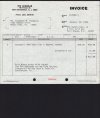How about these two? Just trying to understand the significance of the differences (especially from 1kHz-20kHz).
Again, the challenge is that you are looking at a single test tone, not the whole set of data. As @amirm says, if that single graph was all you needed, he wouldn’t take the time to do all of the other measurements.
What I like to do is to draw the line at around a number that makes sense to you, say -100 dB. If you draw the line across, you can see the bottom one has almost no spikes above -100 dB whereas the L-05m does. So the bottom one is more transparent. The computed number lets you see overall and drawing the line lets you identify the outliers.
Yes, exactly! It was more a leading question -- "DC" as in one of the biggest enemies of speakers?
yum...
Yup. The L-05m uses differential amplifiers which were direct coupled which do in fact provide gain at DC. An capacitive coupled one has inherent DC protection but has band pass characteristics.
Direct-coupled amplifier - Wikipedia
Some DC will be compensated by the differential amplifier, but in order to protect about DC current going to the speaker the Kenwood’s have a protection circuit.
